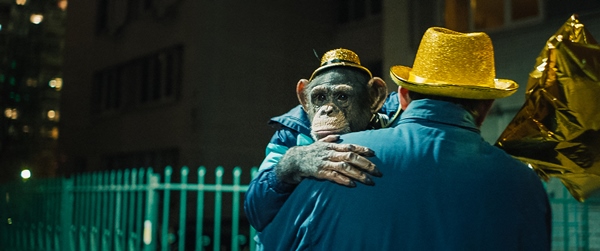
Except for a few in denial, we are all aware of the first forays that humans made into outer space. Less of us, perhaps, know of the animals that were sent there first. Space Dogs focuses on the legacy of our ignorance and lack of curiosity toward them, though not in a straightforward way.
Instead, it follows stray dogs on their meandering, wayward journeys through the streets of Moscow, and while there is occasionally a voice-over, we mostly observe them in silence. These dogs, we are told, are the descendants of Laika, the first dog to orbit the earth. Dogs are the focus, but they are not the only animals here. We also meet chimpanzees and two turtles, other offspring of animals who were sent into the cosmos. These long sequences are occasionally interrupted by archival footage of the first space dogs, usually highlighting the ways in which they were exploited. The result is a fascinating though not entirely successful cinematic experiment.
There is very little in Space Dogs that is not strikingly framed and composed. The streets of Moscow and the surrounding woods are captured in rich, atmospheric cinematography. Often we are made aware of the contrast between encroaching wilderness and decrepit buildings. Early on, we see two dogs make their way through foliage at night, watch them try biting into a car before they realize it is not edible, and see a chimpanzee dressed in human clothing guided by two adults toward a nightclub where the chimp is the entertainment. These animals are either exploited or ignored. Only the downtrodden pay any attention to them, and only intermittently.
It is, however, when the archival footage is introduced that the documentary is at its strongest. In these sequences, it is most direct about its themes. Some of these passages are genuinely difficult to watch—dogs are injected and tied down—but they drive home the idea that, while relentlessly pursuing science and technology, those in charge did not once consider what the animals were experiencing. The narrator asks us, more than once, to imagine what it was like to be in their shoes. What did these dogs dream? How did the two turtles, the first creatures to orbit the moon, experience their drift into space as the shuttle went off course? We cannot, of course, answer these questions, but the film provocatively addresses our inability to even consider them.
In spite of many beautiful images and its intellectual rigor, Space Dogs feels too long at a mere 91 minutes. So many of the sequences involving the stray dogs drag and either illustrate the ideas of the movie too obviously or not at all. While viewers feel compassion for them, their actions are so often not illuminating to observe, and many scenes feel redundant. It is difficult to reconcile this reality with the fascinating material the film draws from and the questions it poses.
So Space Dogs is likely to frustrate many viewers, and it is not for the squeamish, especially a drawn-out sequence of a dog attacking and killing a cat, but it is not without its rewards. It’s a chance to examine the recklessness of our species, and viewers will find ample opportunity in this strange new film.
SPACE DOGS Trailer from Icarus Films on Vimeo.






Leave A Comment